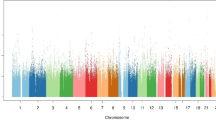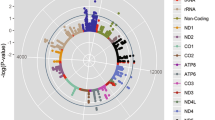Abstract
Although regular exercise improves submaximal aerobic capacity, there is large variability in its response to exercise training. While this variation is thought to be partly due to genetic differences, relatively little is known about the causal genes. Submaximal aerobic capacity traits in the current report include the responses of oxygen consumption (ΔVO260), power output (ΔWORK60), and cardiac output (ΔQ60) at 60% of VO2max to a standardized 20-week endurance exercise training program. Genome-wide linkage analysis in 475 HERITAGE Family Study Caucasians identified a locus on chromosome 13q for ΔVO260 (LOD = 3.11). Follow-up fine mapping involved a dense marker panel of over 1,800 single-nucleotide polymorphisms (SNPs) in a 7.9-Mb region (21.1–29.1 Mb from p-terminus). Single-SNP analyses found 14 SNPs moderately associated with both ΔVO260 at P ≤ 0.005 and the correlated traits of ΔWORK60 and ΔQ60 at P < 0.05. Haplotype analyses provided several strong signals (P < 1.0 × 10−5) for ΔVO260. Overall, association analyses narrowed the target region and included potential biological candidate genes (MIPEP and SGCG). Consistent with maximal heritability estimates of 23%, up to 20% of the phenotypic variance in ΔVO260 was accounted for by these SNPs. These results implicate candidate genes on chromosome 13q12 for the ability to improve submaximal exercise capacity in response to regular exercise. Submaximal exercise at 60% of maximal capacity is an exercise intensity that falls well within the range recommended in the Physical Activity Guidelines for Americans and thus has potential public health relevance.

Similar content being viewed by others
References
Abecasis GR, Cardon LR, Cookson WO (2000) A general test of association for quantitative traits in nuclear families. Am J Hum Genet 66:279–292
Abecasis GR, Cherny SS, Cookson WO, Cardon LR (2002) Merlin–rapid analysis of dense genetic maps using sparse gene flow trees. Nat Genet 30:97–101
Anney RJ, Lasky-Su J, O’Dushlaine C, Kenny E, Neale BM, Mulligan A, Franke B, Zhou K, Chen W, Christiansen H, Arias-Vasquez A, Banaschewski T, Buitelaar J, Ebstein R, Miranda A, Mulas F, Oades RD, Roeyers H, Rothenberger A, Sergeant J, Sonuga-Barke E, Steinhausen H, Asherson P, Faraone SV, Gill M (2008) Conduct disorder and ADHD: evaluation of conduct problems as a categorical and quantitative trait in the international multicentre ADHD genetics study. Am J Med Genet B Neuropsychiatr Genet 147B:1369–1378
Barresi R, Moore SA, Stolle CA, Mendell JR, Campbell KP (2000) Expression of gamma–sarcoglycan in smooth muscle and its interaction with the smooth muscle sarcoglycan-sarcospan complex. J Biol Chem 275:38554–38560
Barrett JC, Fry B, Maller J, Daly MJ (2005) Haploview: analysis and visualization of LD and haplotype maps. Bioinformatics 21:263–265
Blair SN, Kampert JB, Kohl HW, Barlow CE, Macera CA, Paffenbarger RS, Gibbons LW (1996) Influences of cardiorespiratory fitness and other precursors on cardiovascular disease and all-cause mortality in men and women. JAMA 276:205–210
Bouchard C, Dionne FT, Simoneau JA, Boulay MR (1992) Genetics of aerobic and anaerobic performances. Exerc Sport Sci Rev 20:27–58
Bouchard C, Leon AS, Rao DC, Skinner JS, Wilmore JH, Gagnon J (1995) The HERITAGE family study. Aims, design, and measurement protocol. Med Sci Sports Exerc 27:721–729
Chagnon YC, Borecki IB, Perusse L, Roy S, Lacaille M, Chagnon M, Ho-Kim MA, Rice T, Province MA, Rao DC, Bouchard C (2000) Genome-wide search for genes related to the fat-free body mass in the Quebec family study. Metabolism 49:203–207
Chew A, Buck EA, Peretz S, Sirugo G, Rinaldo P, Isaya G (1997) Cloning, expression, and chromosomal assignment of the human mitochondrial intermediate peptidase gene (MIPEP). Genomics 40:493–496
Chew A, Sirugo G, Alsobrook JP II, Isaya G (2000) Functional and genomic analysis of the human mitochondrial intermediate peptidase, a putative protein partner of frataxin. Genomics 65:104–112
Collier CR (1956) Determination of mixed venous CO2 tensions by rebreathing. J Appl Physiol 9:25–29
Cornelissen VA, Arnout J, Holvoet P, Fagard RH (2009) Influence of exercise at lower and higher intensity on blood pressure and cardiovascular risk factors at older age. J Hypertens 27:753–762
Crosbie RH, Lim LE, Moore SA, Hirano M, Hays AP, Maybaum SW, Collin H, Dovico SA, Stolle CA, Fardeau M, Tome FM, Campbell KP (2000) Molecular and genetic characterization of sarcospan: insights into sarcoglycan–sarcospan interactions. Hum Mol Genet 9:2019–2027
de Bakker PI, Yelensky R, Pe'er I, Gabriel SB, Daly MJ, Altshuler D (2005) Efficiency and power in genetic association studies. Nat Genet 37(11):1217–1223
Durbeej M, Campbell KP (1999) Biochemical characterization of the epithelial dystroglycan complex. J Biol Chem 274:26609–26616
Fulker DW, Cherny SS, Sham PC, Hewitt JK (1999) Combined linkage and association sib-pair analysis for quantitative traits. Am J Hum Genet 64:259–267
Hagberg JM, Rankinen T, Loos RJ, Perusse L, Roth SM, Wolfarth B, Bouchard C (2011) Advances in exercise, fitness, and performance genomics in 2010. Med Sci Sports Exerc 43:743–752
Lander ES, Botstein D (1989) Mapping mendelian factors underlying quantitative traits using RFLP linkage maps. Genetics 121:185–199
Larson EB, Bruce RA (1987) Health benefits of exercise in an aging society. Arch Intern Med 147:353–356
Mendoza SG, Carrasco H, Zerpa A, Briceno Y, Rodriguez F, Speirs J, Glueck CJ (1991) Effect of physical training on lipids, lipoproteins, apolipoproteins, lipases, and endogenous sex hormones in men with premature myocardial infarction. Metabolism 40:368–377
Noguchi S, McNally EM, Ben Othmane K, Hagiwara Y, Mizuno Y, Yoshida M, Yamamoto H, Bonnemann CG, Gussoni E, Denton PH, Kyriakides T, Middleton L, Hentati F, Ben Hamida M, Nonaka I, Vance JM, Kunkel LM, Ozawa E (1995) Mutations in the dystrophin-associated protein gamma–sarcoglycan in chromosome 13 muscular dystrophy. Science 270:819–822
Perusse L, Gagnon J, Province MA, Rao DC, Wilmore JH, Leon AS, Bouchard C, Skinner JS (2001) Familial aggregation of submaximal aerobic performance in the HERITAGE Family study. Med Sci Sports Exerc 33:597–604
Physical Activity Guidelines Advisory Committee (2008) Physical activity guidelines advisory committee report. Department of Health and Human Services, Washington, DC
Purcell S, Neale B, Todd-Brown K, Thomas L, Ferreira MA, Bender D, Maller J, Sklar P, de Bakker PI, Daly MJ, Sham PC (2007) PLINK: a tool set for whole-genome association and population-based linkage analyses. Am J Hum Genet 81:559–575
Sham PC, Purcell S, Cherny SS, Abecasis GR (2002) Powerful regression-based quantitative-trait linkage analysis of general pedigrees. Am J Hum Genet 71:238–253
Skinner JS, Wilmore KM, Krasnoff JB, Jaskolski A, Jaskolska A, Gagnon J, Province MA, Leon AS, Rao DC, Wilmore JH, Bouchard C (2000) Adaptation to a standardized training program and changes in fitness in a large, heterogeneous population: the HERITAGE Family Study. Med Sci Sports Exerc 32:157–161
Todorova A, Tournev I, Ninova N, Georgieva V, Kremensky I (2002) Screening for C283Y gamma–sarcoglycan mutation in a high-risk group of Bulgarian Gypsies: evidence for a geographical localization and a non-random distribution among Gypsy subgroups. Community Genet 5:217–221
Trabelsi M, Kavian N, Daoud F, Commere V, Deburgrave N, Beugnet C, Llense S, Barbot JC, Vasson A, Kaplan JC, Leturcq F, Chelly J (2008) Revised spectrum of mutations in sarcoglycanopathies. Eur J Hum Genet 16:793–803
US Department of Health and Human Services (1996) Physical activity and health: a report of the Surgeon General. US Dept of Health and Human Services, Centers for Disease Control and Prevention, National Center for Chronic Disease Prevention and Health Promotion, Atlanta, GA
Wilmore JH, Farrell PA, Norton AC, RWd Cote, Coyle EF, Ewy GA, Temkin LP, Billing JE (1982) An automated, indirect assessment of cardiac output during rest and exercise. J Appl Physiol 52:1493–1497
Wilmore JH, Stanforth PR, Turley KR, Gagnon J, Daw EW, Leon AS, Rao DC, Skinner JS, Bouchard C (1998) Reproducibility of cardiovascular, respiratory, and metabolic responses to submaximal exercise: the HERITAGE Family Study. Med Sci Sports Exerc 30:259–265
Wilmore JH, Stanforth PR, Gagnon J, Rice T, Mandel S, Leon AS, Rao DC, Skinner JS, Bouchard C (2001a) Cardiac output and stroke volume changes with endurance training: the HERITAGE Family Study. Med Sci Sports Exerc 33:99–106
Wilmore JH, Stanforth PR, Gagnon J, Rice T, Mandel S, Leon AS, Rao DC, Skinner JS, Bouchard C (2001b) Heart rate and blood pressure changes with endurance training: the HERITAGE Family Study. Med Sci Sports Exerc 33:107–116
Acknowledgments
The HERITAGE Family Study is currently supported by NIH/NHLBI grant R01 HL045670. C. Bouchard is partially supported by the John W. Barton Sr. Chair in Genetics and Nutrition. T. Rice and D.C. Rao are also partly supported by NIH/NIGMS grant R01 GM28719. We wish to thank all PIs who contributed to the HERITAGE Family Study in the past via support from the National Heart, Lung, and Blood Institute through the following grants: C Bouchard (HL-45670); AS Leon (HL-47323); DC Rao (HL-47317); JS Skinner (HL-47327); JH Wilmore (HL-47321). The present address for author George Argyropoulos is Weis Center for Research, Geisinger Clinic, Danville, PA 17822-2615, for author Adrian M. Stütz is European Molecular Biology Laboratory, 69117 Heidelberg, Germany, and for author Margarita Teran-Garcia is Division of Nutritional Sciences, University of Illinois at Urbana-Champaign, Urbana, IL 61801.
Conflict of interest
The authors declare there are no conflicts of interest.
Author information
Authors and Affiliations
Corresponding author
Additional information
Communicated by Martin Flueck.
Electronic supplementary material
Below is the link to the electronic supplementary material.
Rights and permissions
About this article
Cite this article
Rice, T.K., Sarzynski, M.A., Sung, Y.J. et al. Fine mapping of a QTL on chromosome 13 for submaximal exercise capacity training response: the HERITAGE Family Study. Eur J Appl Physiol 112, 2969–2978 (2012). https://doi.org/10.1007/s00421-011-2274-8
Received:
Accepted:
Published:
Issue Date:
DOI: https://doi.org/10.1007/s00421-011-2274-8




